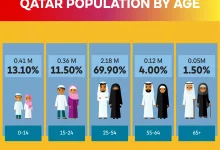The Kingdom of Saudi Arabia, a country located in the Middle East on the Arabian Peninsula, has experienced significant population growth and demographic changes in recent decades. As of the latest available data in 2022, Saudi Arabia’s population is estimated to be approximately 35 million people. This figure is derived from various national and international sources, including estimates by the Saudi Arabian government and demographic studies conducted by international organizations.
The population of Saudi Arabia is characterized by a diverse demographic profile, influenced by both natural growth and significant levels of international migration. The country’s rapid economic development, particularly since the discovery of oil in the 20th century, has attracted a large number of expatriates, contributing to the country’s demographic composition. The presence of a substantial expatriate workforce, primarily from countries such as India, Pakistan, Bangladesh, and the Philippines, has played a crucial role in the country’s labor market and economic development.
Saudi Arabia’s population density varies significantly across its vast territory. The majority of the population is concentrated in urban areas, particularly in major cities such as Riyadh, Jeddah, and Dammam. Riyadh, the capital city, is the most populous urban center, with a population of over 7 million people. Jeddah, located on the Red Sea coast, is another major urban hub with a population exceeding 4 million. Dammam, in the Eastern Province, also serves as a significant economic and population center.
The demographic structure of Saudi Arabia reflects a relatively young population. The median age of Saudi citizens is relatively low, with a substantial proportion of the population being under the age of 30. This youthful demographic profile is a result of high birth rates in previous decades, although the fertility rate has been gradually declining in recent years. The youth bulge presents both opportunities and challenges for the country, as it impacts education, employment, and social services.
In addition to natural population growth, Saudi Arabia’s demographic landscape is shaped by its immigration policies and labor market demands. The country’s reliance on foreign labor is a notable feature of its economy, with expatriates constituting a significant portion of the workforce. These foreign workers are employed in various sectors, including construction, domestic services, and hospitality. The presence of a large expatriate population has led to a diverse cultural and social environment in urban centers, where various cultural practices and traditions coexist.
The Saudi government has undertaken several initiatives to address demographic and labor market challenges. The Vision 2030 plan, announced in 2016, aims to diversify the economy and reduce the country’s dependence on oil revenue. As part of this plan, there are efforts to increase the participation of Saudi citizens in the workforce and enhance the quality of education and training. These efforts are designed to better align the skills of the Saudi workforce with the needs of a modernizing economy and to create opportunities for young Saudis.
Saudi Arabia’s population is also influenced by various social and cultural factors. The country is known for its conservative social norms, which impact various aspects of daily life, including gender roles and family structures. The government has introduced reforms in recent years to promote gender equality and improve women’s participation in the workforce and public life. These reforms are part of broader efforts to modernize the country and address social issues while maintaining cultural and religious traditions.
In terms of health and education, Saudi Arabia has made significant strides in improving living standards and access to services. The government has invested heavily in healthcare infrastructure, leading to improved health outcomes and increased life expectancy. Educational reforms and investments in higher education institutions have also contributed to a more educated population, although challenges remain in ensuring that educational outcomes meet the demands of a rapidly evolving labor market.
Overall, Saudi Arabia’s population dynamics are shaped by a combination of natural growth, international migration, and socio-economic policies. The country’s demographic profile reflects its role as a major economic and cultural hub in the Middle East, with ongoing efforts to address challenges and leverage opportunities for development. As Saudi Arabia continues to evolve, its population will remain a key factor in shaping its future trajectory and development.

